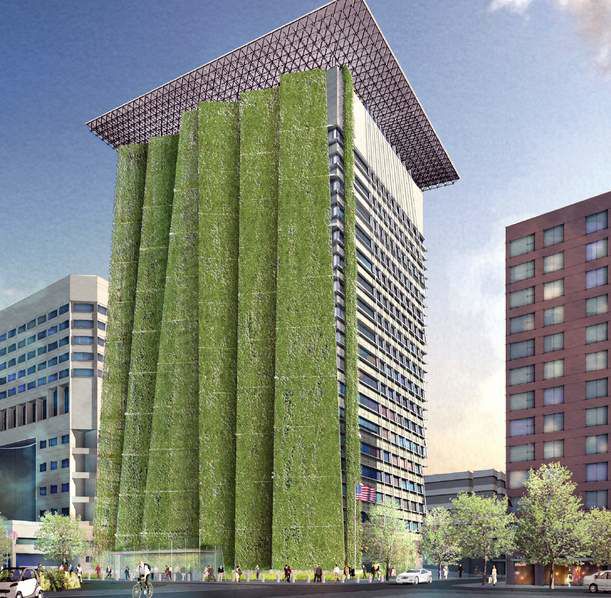Super green: Portland office to get 250-foot-tall trellises
Published 4:00 am Sunday, January 17, 2010

- A computer-generated architectural image shows a series of 250-foot-tall trellises designed to shade the west side of the 18-story Edith Green-Wendell Wyatt Federal Building in Portland.
PORTLAND — They haven’t figured out yet how to get the pruning done, but architects and federal officials plan one of the world’s most extensive vertical gardens in downtown Portland — what amounts to a series of 250-foot-tall trellises designed to shade the west side of an 18-story office building.
It is not a new idea to use greenery vertically as “living architecture,” running plants up the sides of a building to keep it cool.
But even in a city with a reputation for rain-fed greenery as well as for green architecture, the wall of the Edith Green-Wendell Wyatt Federal Building would stand out.
The architects’ plans call for seven vertical, “vegetated fins” to jut at acute angles. The fins would be the metal framework for planters and the greenery sprouting from them.
The west wall is 150 feet long, making the expanse to be shaded about three-quarters the size of an NFL playing field, minus the end zones.
The work is part of a $135 million remodeling effort, with most of the money from federal stimulus funds. It is the largest single stimulus project announced so far in Oregon. The U.S. General Services Administration says its goal is to create a “landmark high-performance building.”
The green wall concept is familiar to anyone who has planted a deciduous tree or used a vine-covered trellis on the west side of the house: In the summer, the leaves provide cooling shade; in the winter, the bare limbs and stems admit comforting light.
“If you think about it, it’s a planter every 25 feet,” architect Don Eggleston said. “A lot of people have 10-foot trellises in their gardens.”
Eggleston’s firm, SERA Architects, is working on some questions that weekend gardeners never have to figure out: what plants will grow readily at more than 200 feet in the air and how to water, fertilize, weed and prune at that height.
The pruning might be done in much the same way windows are washed, he said, with workers hoisted and lowered on platforms.
Rainwater collected on the roof, supplemented by city water, will be piped for irrigating the green wall, he said.
The building is a modern- ist, International-style high-rise completed in 1975 and named for two U.S. representatives from northwest Oregon. Across a city park, it is face-to-face with City Hall.
It hasn’t gotten a great deal of respect in Portland. Bart King, author of a local guidebook to the city’s architecture, said he found it ugly and boring, so he didn’t include it.
It hasn’t aged well, either. Its precast concrete facade has settled, opening gaps around its single-pane windows, and it’s leaking air and water, said Kevin Kampschroer, the General Services Administration official in charge of the greening of the federal buildings.
“It’s not structurally unsound, but it’s not going to get any better,” said Kampschroer.
Construction is expected to take 30 to 40 months. Federal workers are beginning to move to temporary quarters.






